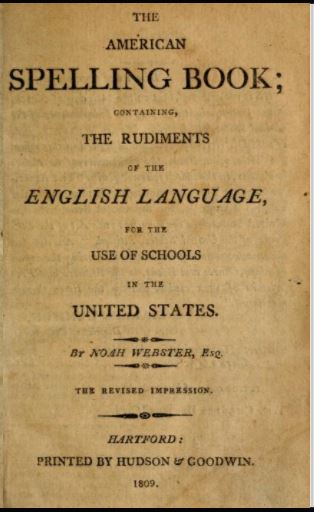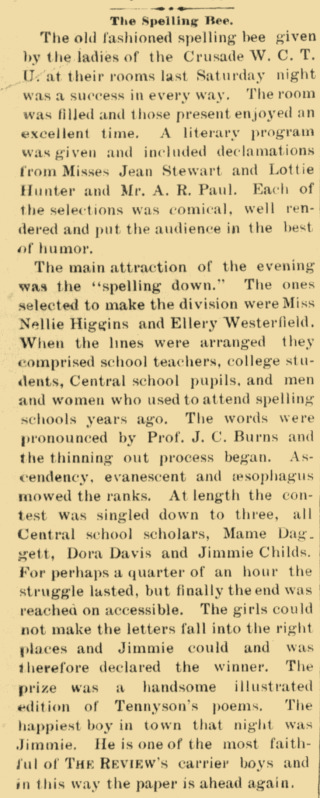|

October 5, 2020
#336
Thank you,
Barbara Schock, for sharing your extraordinary gift of these vignettes of Galesburg &
19th century American history.

1809 edition of Noah Webster's The American Spelling Book
|
The Spelling Bee By Barbara
Schock
During the Revolutionary War Noah Webster (1758-1843)
published the American Spelling Book. It went through 385 editions. By 1890 the
book had sold sixty million copies. The words were easily taught and their
difficulty progressed by age. There were no references to religion in the
spelling book.
The Pilgrims had used spelling matches to encourage
reading of religious books. At that time there was no recognized authority on
the proper spelling of words. They were more concerned about the proper
pronunciation of the words. There were also strict rules to prevent any
frivolity during the contests.
Webster’s book was frequently called “the blue-backed
speller” as that was the color of the cover. Webster was committed to the
simplification of the spelling of words and the idea of a unified American
culture.
Publication of the speller led to the American custom of
the spelling bee. Bee or been is an English expression meaning to help a
neighbor. In this country it was applied to farm work or household tasks such as
quilting. As the frontier moved across the continent, the custom moved along
with it.
During the Civil War (1861-1865) soldiers wrote home to
their family members and friends. Reading through the surviving letters is
interesting and sometimes difficult as the soldiers wrote words just as they
sounded. Many of them had gone to school in rural areas which operated only in
the winter when there was less farm work to be performed. Orthography, the art
of writing words was the proper letters, was a small part of their experience.
In 1806 Webster published a Comprehensive Dictionary of
the English Language. It contained 70,000 words. It is still published today as
the Merriam-Webster dictionary. The Merriam Company purchased the rights from
Webster’s heirs.
In the 1880s teachers began conducting classroom spelling
contests as a way to motivate students to spell more correctly. Mary and Carl
Sandburg, the two oldest children of August and Clara Sandburg, would have
been attending school in Galesburg at that time. More than likely they
participated in classroom spelling matches.
In 1905 the United States Spelling Bee was held in
Cleveland during the National Education Association convention. In 1925 the
Courier-Journal of Louisville, Kentucky, then took up the idea of sponsoring a
national spelling contest. The Scripps-Howard News Service acquired sponsorship
in 1941 and continues to conduct the contest. ESPN has broadcast the event for a
number of years. Unfortunately, the contest wasn’t held this year.
The students who participate attempt to memorize a 3,000
page dictionary. They improve their spelling, increase their vocabulary, learn
concepts about many things and develop correct English usage of words. An annual
study list is published in print and on line so young people can use it.
Carl Sandburg spent his life writing words in ways to
amuse, explain, elucidate, arouse curiosity, to elicit emotions, to make the
reader think. He may have been a good “speller” too.
Article on a Monmouth, Illinois Spelling Bee
from the
Monmouth Review (February
11, 1890), p.2

|

